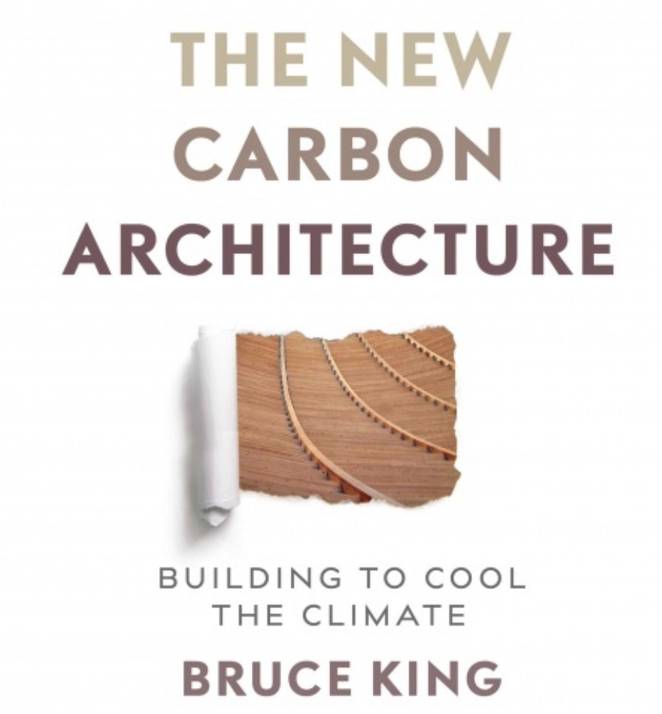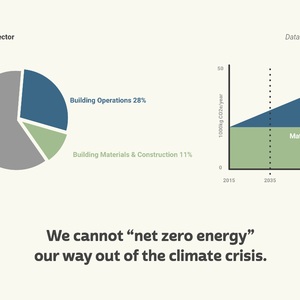
Image Credit: New Society Publishers
Burning fossil fuels or using electricity results in carbon dioxide emissions (unless the electricity is produced by photovoltaics, wind, or another renewable energy source). Since CO2 emissions cause global climate change, environmentally conscious builders aim to build energy-efficient buildings.
Having an energy-efficient home is good for the homeowner, of course, but homeowners aren’t the only ones who use energy. Builders and building materials manufacturers also use energy. There are significant CO2 emissions associated with the energy required to produce building materials and build buildings — energy referred to as the “embodied energy” of the construction project. (For more on embodied energy, see All About Embodied Energy.)
There are two types of energy associated with a building over its lifetime: embodied energy and operating energy. For a well-insulated efficient building, embodied energy may amount to between 15% and 50% of the building’s total lifetime energy use.
If you are an environmental activist interested in addressing climate change, you’re probably aware of the following two facts:
- In order to prevent an irreversible change in the planet’s climate, humans have to make drastic reductions to our CO2 emissions within the next 15 to 20 years. If we make these changes in 25 or 30 years, the changes will come too late to save the planet.
- Embodied energy is “front loaded.” If you are building a house in 2018, all of the embodied energy gets burned this year, which means that all of the CO2 associated with that embodied energy is going into the atmosphere this year. Even if the building is efficient to operate, that operating efficiency won’t matter much if the front-loaded energy associated with the building’s construction helped doom the planet.
In short, for anyone concerned about climate change, embodied energy really, really matters.
What is “embodied carbon”?
A recently published book, The…
Weekly Newsletter
Get building science and energy efficiency advice, plus special offers, in your inbox.

This article is only available to GBA Prime Members
Sign up for a free trial and get instant access to this article as well as GBA’s complete library of premium articles and construction details.
Start Free TrialAlready a member? Log in















14 Comments
Foam vs. concrete
Thanks for another good critique of a useful book that could have been better, and for providing pragmatic advice. I think it's worth elaborating the impact of foam insulation a bit. Given the central role of concrete in CO2 emissions from construction, I found it useful to use that as a reference point for comparison. Per cubic foot, the global warming potential of emissions from XPS foam is ten times higher than from concrete. On the other hand, from EPS or polyiso, it's five time lower than concrete.
In the spirit of simplifying the short list, I think it's reasonable to consider concrete and high GWP foam the only materials that are problems worth worrying about, and to remember that high GWP foam--XPS and most closed-cell spray foam--is an order of magnitude worse than concrete.
Response to Charlie Sullivan
Charlie,
Thanks for the quantification of the climate impact of XPS and most brands of closed-cell spray foam, and for the helpful advice.
Charlie
I second Martin's thanks. Both Martin and your lists reducing a complex topic down to a few prescriptive axioms are very helpful.
My thoughts on this week's blog
These types of books and articles, usually talk about a smaller sector of the (residential) construction industry, as if we all live in rural America or New England. We must recognize that the greatest majority of homes built in the US are built by production builders in large markets, up to ±70%. See attached NAHB charts.
Designing and building high-performing and zero energy (ready) homes for most of my professional life in several states, and mostly custom or small production, I can tell you that some of the information and advice in this blog is out of touch with OUR, and most production builder reality, and the reality of the mid/major cities combined.
• “Don’t build new buildings” – In Dallas (DFW), houses built 20-100 years ago are very expensive to retrofit to high-performing levels, and most people do not have unlimited budgets. Most retrofit money is spent on the HGTV “lipstick on a pig” philosophy. There is no way to “harvest” our own wood, or make our own adobe bricks and straw bales, so we have to go with the most economically viable solutions for large markets.
• “Remodeling an existing building is better for the planet than most types of new construction” – During 2017 in DFW, the top house market in the country, there were 98k homes sold… 2/3 were existing and 1/3 new. There are not enough built houses to remodel to satisfy the demand of all new folks moving to NTX, and the ones that were remodeled, see point above.
• “…a significant part of the company's carbon emissions come from transportation” Really? Solutions anyone? I don’t see mass transportation going to must suburbs were production builders build, and subcontractor’s companies come from all over the metro area.
Response to Armando Cobo
Armando,
I gave advice. Advice is cheap. Do I expect any readers to take my advice? No.
So what's going to happen?
The U.S. home building industry will continue conducting business as usual. New homes will be built, and lots of CO2 will be released into the atmosphere as a result of builders' actions. Workers will drive their pickup trucks to job sites in the suburbs to build these homes.
Some GBA readers will build homes with extra insulation and triple glazing -- above-code features that (when manufactured and delivered to the job site) will emit even more CO2 into the atmosphere than materials destined for homes with code-minimum insulation and double glazing.
U.S. home builders are unlikely to leave the well-trodden path of business as usual. Of course, builders aren't the biggest climate culprits. But it's fair to say that Americans and Canadians -- whether they work as builders or architects or doctors or schoolteachers or firefighters -- emit far more carbon per person than Somalis or Ugandans.
CO2 emissions in the U.S. and across the globe will continue to increase, and average global temperatures will continue to rise. By 2035 or 2040, our actions will have caused an irreversible and catastrophic change in our climate that will lead to rapid melting of polar ice caps and rising sea levels.
Species will continue to go extinct at a rapid rate -- a mass extinction event that will remain in the fossil record for millennia.
Millions of climate refugees will leave their homes, in desperate search of a safe haven.
It's very hard to see a likely path to avoid these predictions.
One more point, Armando
Armando,
You wrote, “Most retrofit money is spent on the HGTV 'lipstick on a pig' philosophy. There is no way to 'harvest' our own wood, or make our own adobe bricks and straw bales.”
I agree completely. Some of the authors of the book I reviewed (The New Carbon Architecture) implied that adobe and straw are part of the solution to the climate change crisis, and I disagree. As I wrote in my review, "Today’s builders aren’t provided any specific advice on new approaches for foundations. This is part of a pattern. The chapter on straw bale construction touts products (straw wall panels and straw blocks) that are still under development or unavailable in the U.S. ... The chapter on clay (adobe) construction sings the praises of clay without providing any specific guidance to U.S. builders."
That's why my predictions are so pessimistic, and why my unrealistic advice is likely to fall on deaf ears.
We sit At The Same Table
Martin,
You have said what needs to be said, we are headed for a train wreck. Even drastic actions today will most likely be ineffective in curbing runaway climate change. GBA has provided a forum for thoughtful discussion on building greener with our limited fossil energy in mind. Let this much needed discussion continue.
> It's very hard to see a
> It's very hard to see a likely path to avoid these predictions.
About 50 years of mandatory birth control? Oh, you said likely.
Slightly more seriously, I suggest fixing the federal budget deficit with carbon taxes.
Response to Jon R
Jon,
As I have said many times, the imposition of steep carbon taxes would be a logical response by government leaders to our current climate crisis. Although policy experts and climate scientists have made the suggestion for decades, U.S. leaders have so far failed to implement this suggestion.
"In fact, a 14-inch-thick
"In fact, a 14-inch-thick straw bale wall has an R-value of R-20 to R-28. An R-20 wall barely meets code in Zones 3 through 5, and is less than minimum code requirements in Zones 6, 7, and 8."
It's a mistake to use center-cavity prescriptive R-values for framed buildings when assessing the code-compliance or thermal performance of other types of construction. In fact R20 straw bale construction can meet code minimum requirements everywhere in the US.
Straw bale construction has nowhere near the thermal bridging of framed buildings, since they not stacked between 2x framing timber. They comparable to (but usually less than) the thermal bridging of a Larson Truss, with a whole-wall R close to the center-cavity R value.
Code min in zones 6 through 8 is a maximum of U0.045, or R22.2 "whole wall". If the hay bale itself Is R20, the air films plus interior & exterior finish materials can bring it over that mark. If the hay bale itself is R24 (mid-range of the estimate) it's a no-brainer, unless the designer goes WAY out of the way to subvert thermal performance with the structural elements.
But thickness notwithstanding, those aren't "super insulated" walls, except relative to code requirements of zones 1& 2, and only ~1.5x code performance for zones 3 through 5.
Response to Dana Dorsett
Dana,
I agree with your analysis. I was simply referring to the minimum R-value requirements from the prescriptive table. You're right, however, that other code compliance paths make more sense for straw bale builders, since the other compliance paths provide more credit for a straw bale wall.
Carbon Sequestration
“If your main goal is to sequester carbon, one of the best things we can do with forests is to keep them around and let them grow old.”
This doesn't seem aligned with the evidence and information provided by the IPCC. Dr. Werner Kurz of Canada's Pacific Forestry Centre (also a contributor to the IPCC) has done extensive research on forest carbon budgets. The answer is not simple, but generally, it is better to remove a tree from a forest, replace it, and convert it into a long-lived product than to leave it in the forest.
This is one of his presentations to the Pacific Institute for Climate Solutions:
https://www.youtube.com/watch?v=6re-PTjebWA
Response to Robert Lepage
Robert,
My review noted, “Is this temporary sequestration of carbon good or bad for the planet? Suffice it to say that the answer is, 'it depends' — and the calculation isn’t simple.”
I urge anyone interested in diving deeper into this issue to buy the book under review (The New Carbon Architecture). Remember that the authors of The New Carbon Architecture are focused on climate solutions that reduce CO2 releases during the next 10 or 15 years, and specifically aim to avoid "solutions" that involve large front-loaded releases of CO2 that are made up over the next 100 years by a delayed balancing factor — for example, long-term forest regeneration that takes decades to occur.
Here is a longer quote from The New Carbon Architecture:
"...[W]hen it comes to carbon, not all wood is equal: wood may be good, but wood from good forestry is much better. This is true not only when it comes to combating global warming but for myriad other reasons as well.
"In our search for solutions to the climate crisis, we tend to miss the forest for the timber. If your main goal is to sequester carbon, one of the best things we can do with forests is to keep them around and let them grow old. Older forests generally capture and store far more carbon over time than do younger forests. And the oldest forests store the most: what remains of the Pacific coast's original ancient forests are among the greatest carbon sinks on the planet...
"Much is made of the fact that wood stores carbon for the length of its life in a building, ignoring the fact the carbon embodied in wood products accounts for only a fraction of the overall carbon stored in the forest they come from — as little as 18 percent by one estimate. Of the remainder, large amounts may be released to the atmosphere when logging slash rots and soils are exposed by logging. For decades after they occur, clearcuts emit more carbon than regeneration absorbs in spite of the rapid growth rate of young trees. This is because decomposer microbes in the soil work more quickly after a stand is logged, releasing CO2 as they decompose branches, roots, and other organic matter.
"...[C]onventional LCA [life cycle assessment] does not currently address harm that logging may cause to the integrity and diversity of forest ecosystems, to water quality, or to threatened and endangered species.
"Most experts contend that LCA's omissions are not due to any deliberate attempt to deceive, but rather because LCA is the wrong tool for the job — it doesn't have the capacity to reliably measure forest carbon or ecological impacts, much less regulate them."
Response to Martin
Hi Martin,
The issue follows:
"If your main goal is to sequester carbon, one of the best things we can do with forests is to keep them around and let them grow old."
In isolation, this is true, but as you rightly indicated, reality is much more complicated rendering this statement unfortunately false. Dr. Kurz' work demonstrates the shortcomings of many of the points indicated in your quoted section of The New Carbon Architecture, using peer reviewed and scientific research. The video linked above provides a good summary of the concept.
A few snippets:
Climate change mitigation strategies in the forest sector: biophysical impacts and economic implications in British Columbia, Canada. 2017. Xu, Z.; Smyth, C.E.; Lemprière, T.C.; Rampley, G.J.; Kurz, W. A. Mitig Adapt Strateg Glob Change, pp 1–34
Modelling forest carbon stock changes as affected by harvest and natural disturbances. II. EU‑level analysis. 2016. Pilli, R.; Grassi, G.; Kurz, W.A.; Moris, J.V.; Vinas, R.A. Carbon Balance Manage 11:20.
Estimating product and energy substitution benefits in national-scale mitigation analyses for Canada. 2016. Smyth, C.; Rampley, G.; Lemprière, T.C.; Schwab, O.; Kurz. W.A. GCB Bioenergy
Estimating carbon dynamics in forest carbon pools under IPCC standards in South Korea using CBM-CFS3. 2016. Kim, M.; Lee, W.; Kurz, W.; Kwak, D.; Morken, S.; Smyth, C.; Ryu, D. iForest - Biogeosciences and Forest.
Constraining the organic matter decay parameters in the CBM-CFS3 using Canadian National Forest Inventory Data and a Bayesian inversion technique. 2017. Hararuk, O.; Shaw, C.; Kurz, W.A. Ecological Modelling 364(2017):1-12.
Climate change mitigation potential of local use of harvest residues for bioenergy in Canada. 2017. Smyth, C., Kurz, W. A., Rampley, G., Lemprière, T.C., Schwab, O. GCB Bioenergy, 9: 817–832.
Best,
Rob
Log in or become a member to post a comment.
Sign up Log in